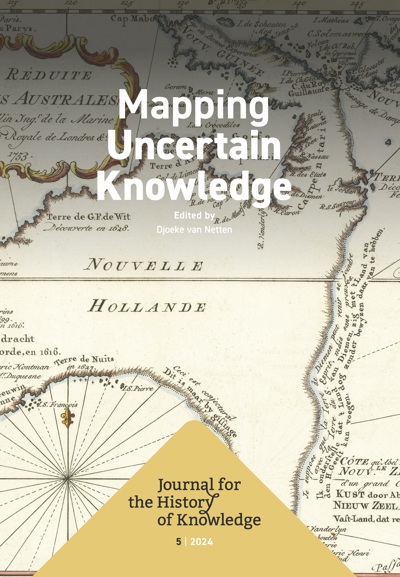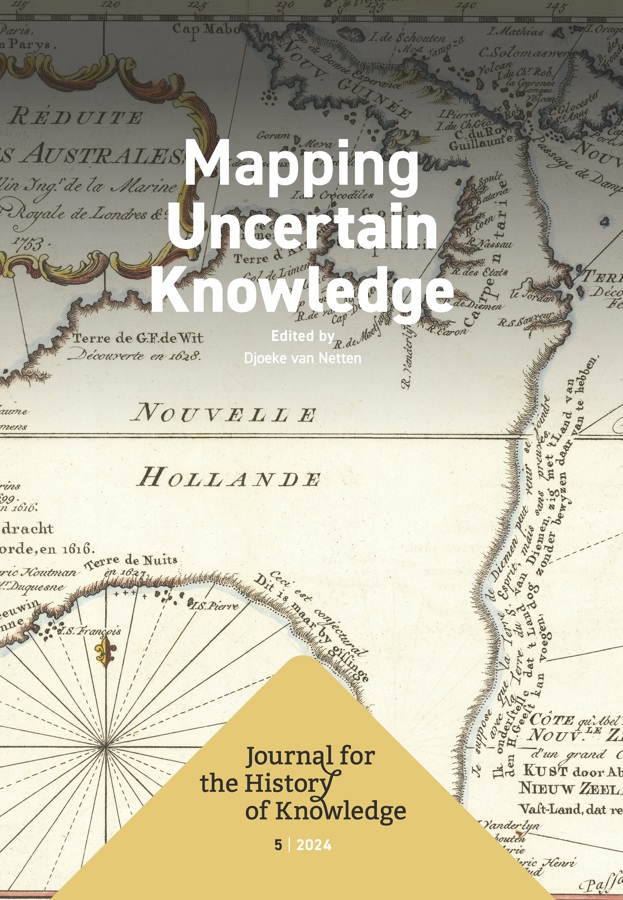
Journal for the History of Knowledge 5 (2024)
Special Issue: Mapping Uncertain Knowledge, edited by Djoeke van Netten
Djoeke van Netten (ed)
- Pages: 376 p.
- Size:178 x 254 mm
- Illustrations:90 col.
- Language(s):English
- Publication Year:2025
- € 88,00 EXCL. VAT RETAIL PRICE
- ISBN: 978-2-503-60843-3
- Paperback
- Available
How to present uncertain knowledge? What did, and what do, mapmakers do when they are not sure? This posed a large problem in early modern times, the so-called "age of exploration." Where and how to insert whole new continents, disputed discoveries, questionable coastlines, and islands beyond the imagination? What if the experiences of explorers contradicted age-old narratives? And how to present the yet unexplored parts of the world? Visualizing uncertain information on a map, however, is not just an early modern issue. Twenty-first-century scholars making maps, for example with Geographic Information Systems (GIS), face comparable problems. How to state "maybe" or "I don’t know" with only ones and zeros at your disposal? Where to draw the line? How to demonstrate, or hide, your uncertainty? In this special issue, we bring together experts on the presentation of knowledge in the form of maps. The various case studies from different parts of the world will be related to bigger developments, not only regarding the technology and production of maps, but also considering practices of acquiring and disseminating knowledge, European expansion and empire building. The final section of the special issue features input from the fields of digital humanities and cartopology, also analysing the interactions between people, their knowledge, and their maps.
Special Issue: Mapping Uncertain Knowledge
Edited by Djoeke van Netten
Djoeke van Netten, Introduction. Mapping Uncertain Knowledge
Chet Van Duzer, Some Methods for Indicating Cartographic Uncertainty, Fifteenth through Eighteenth Centuries
Petter Hellström, A New New World. Unmapping Africa in the Age of Reason
Gianamar Giovannetti-Singh, Interesting and Uninteresting Unknowns. Mapping Southern Africa in the Seventeenth Century
Danielle Gravon, Gerhard Mercator as Sacred Geographer. Paradise at the North Pole
Weixuan Li, Deep Mapping Uncertain Historical Sources. Visualizing Business Knowledge of Painters in Seventeenth-Century Amsterdam
Rombert Stapel, To Map, To Ascertain. Reflections on the Practice of Mapping (Un)certain Knowledge from a Digital Humanities Perspective
Marlies Vermeulen, Epilogue. Mapping Uncertainties
Forum: Decentering the History of Knowledge
Sven Dupré and Geert Somsen, Introduction. Decentering the History of Knowledge
Kenji Ito, Who Knows?
Projit Mukharji, Vernacularizing, Braiding, and Plurigenericism. An Expanding Toolkit for Histories of Knowledge in Non-Settler Postcolonies
Michiel Leezenberg, For a Multiple Decentering of the History of Knowledge
Andrés Vélez-Posada, Contact Zones for a Global History of Knowledge
Eugenia Lean, Notes from Global Asia. How to Write a Global History of Knowledge
Harun Küçük, From Universal to Global. Real Challenges and Utopian Hopes for the Global History of Knowledge
Helen Tilley, Ignoring the Obvious about the World. For Kinds of Not Knowing in African Studies
Irina Podgorny, Traveling Mermaids, Traveling Materials. Museum Objects and the De-Centering of the Histories of Knowledge
Anna Grasskamp, Response
Research articles
André de Melo Araújo, (Re)producing the English Printed Past. Antiquarian Knowledge-Making Practices in Joseph Ames’s Typographical Antiquities (1749)
Lotte Schüßler, Distance Education During a Paper Shortage. Wartime Economics, Efficiency, and the Nazi Humanities at the Front
Marte Van Hassel, Nele Wynants & Karel Vanhaesebrouck, A Lantern View from the Ruwenzori Mountain Range. Between Science Communication, Travel Story, and Colonial Propaganda in an Illustrated Lecture Performance from 1932
Genevieve E. Caulfield, The Optics of St Francis’s Stigmatization. Iconography and Theories of Seeing


